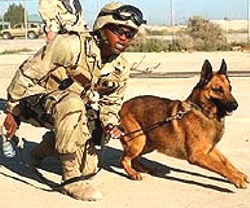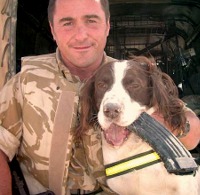   |
 (By Karen Fanning) A U.S. Navy dog-handler issues commands to his military working dog, Argo, while conducting a simulated training drill in Kuwait. Argo, who is trained as a bomb and patrol dog, has served in the Navy for about one year. (Photo: U.S. Navy Photo by Photographer's Mate 1st Class Ario K. Abrahamson) They're loyal soldiers in the Army, Navy, Air Force, and Marines. But these are no ordinary warriors. They're the proud battalion of elite military dogs who will accompany American soldiers onto the battlefield. While the U.S. won't reveal just how many dogs are called to duty, nearly 1,400 currently serve as American soldiers. They are trained to detect bombs and land mines, and rescue wounded soldiers. Two breeds in particular, the Belgian Malinois and the German shepherd, are favored for their strength and work ethic.
Not all Americans are applauding the military's use of animals in combat. People for the Ethical Treatment of Animals (PETA) has openly criticized what they consider inhumane tactics. "These animals never enlisted; they know nothing of Iraq or Saddam Hussein, and they probably won't survive," says Arathi Jayaram, a spokesman for PETA, an animal rights group. "The military can detect weapons and find wounded troops with some very sophisticated equipment." That isn't always the case, say military officials. Animals have unique gifts—low-light vision, biological sonar, and directional hearing—that can't be duplicated even with the most-advanced technology. The U.S. military also points to a long history in which America's creatures have successfully served their country. Until the end of World War I, horses provided transportation for soldiers. In the late 1950s, the Navy began using bottlenose dolphins to locate mines. During the Vietnam War, dogs tracked down booby traps and lugged wounded soldiers to safety.
"[They] have contributed to the security of our nation and the freedom of our people," he says. "These are not ordinary dogs, but loyal, spirited, and courageous animals." (Post-Gazette, March 27, 2003) Hannibal's elephants crossed the Alps to battle the Romans 2,200 years ago. Combat dogs have fought wars for centuries. Pigeons performed messenger duty in World War II. There never would have been a cavalry without horses. Even glow worms have served in the military. All sorts of animals have been enlisted -- or drafted -- for wartime duty. Many have served far more dangerous duty than the dolphins pressed into service against Saddam Hussein. Hannibal's elephants died in droves as the general from Carthage forced them over the Alps. The Romans killed more in the ensuing battles. At least 8 million horses, mules and donkeys died in World War I, according to a British estimate. Use of pack mules continued in WWII, with 10,000 used in Greece alone. Some 100,000 pigeons in World War I and 200,000 in World War II flew messenger missions, and they suffered huge losses. Coalition forces in Iraq are using pigeons, too -- as chemical warfare detectors. They will serve by dying, to alert troops of a chemical attack. War dogs have been a battlefield fixture throughout history. Scout dogs sniffed out enemy positions; message dogs carried communiques; medic dogs rescued wounded soldiers. Germany used 30,000 messenger and ambulance dogs in WWI. When the French demobilized, they killed 15,000 dogs, according to a 1952 U.S. Army history of war dogs. The U.S. Army trained 10,000 dogs for WWII, and canines served with great valor in Korea, Vietnam and the first Gulf War. (By Maryann Mott for National Geographic News Apr 9, 2003 ) Since the terrorist attack on the World Trade Center, the U.S. security forces have stepped up efforts to train and deploy explosive-detection dogs. This year about 350 canines, nearly double the regular intake, will go through a five-month long training program at Lackland Air Force Base in San Antonio, Texas. The base is the only facility in the country that trains dogs for the U.S. Army, Navy, Air Force, and Marine Corps. Canines are dual certified in explosive detection and patrol, which means they will attack on command, or, to protect themselves or their handler. After training, they are posted to military installations worldwide. Right now bomb-detection dogs are being used by coalition forces in the Iraq war. Details, though, on how many canine teams are in the Middle East, and what kind of work they are doing, are secret because of security concerns, according to U.S. Central Command, in Doha, Qatar. Major Frank W. Schaddelee, commander of the 341st Training Squadron, which procures and trains all military working dogs, said explosive detection dogs are not used in direct combat situations. Instead, they may be used at "points of entry" or for "VIP sweeps," where buildings and cars are searched for bombs before dignitaries arrive. On average, these four-footed soldiers are 98 percent accurate in their detection abilities, he said, and depending on the task and climate, can work up to 12 hours a day. Belgian Malinois (pronounced MAL-in-wah) and German shepherds are used because they are intense, intelligent, and known for their ability to work hard. At first glance, a Malinois might be mistaken for a shepherd. Both breeds are the same size and have similar coat coloring and markings. Peace of Mind The majority of these medium sized dogs are bought from European breeders. About four times a year military personnel travel overseas and look at hundreds of animals, ranging in age from 12 to 36 months. About one third of the dogs viewed are purchased. Each dog costs U.S. $3,100, said Schaddelee, but once trained, they are worth about $11,000. He's quick to point out, though, that their value is much greater. "I don't think you can put a real price on their heads because of the peace of mind that they give the troops with their capability of detection/deterrence," he said. During the hundred-day training program at Lackland, the dogs are worked five days a week, using a repetition and reward system. As a reward, they are given a ball or rubber chew toy. "It all turns into a great big game for the dog," said Technical Sergeant Curtis Henthorn. Schaddelee would not say how many, or what types of explosives the dogs can detect. But in a war situation, for example, he said if there is an unfamiliar substance being used, they can quickly be trained to detect it. Handlers are also taught at the base and go through an 11-week course. The Nose Knows Dogs rely on their sense of smell much the same way humans rely on their eyesight. And for good reason. "The number of smell receptors in a human's nose ranges from 5 million to 15 million, whereas in a dog, it can range from 125 million to 250 million," said Donald Perrine, a veterinarian at Parkside Animal Medical Center in Fountain Hills, Arizona. In addition to more scent cells, Perrine said the olfactory portion of a dog's brain is four times larger than a human's. Their wet, black noses are so sensitive they can detect minute odors. In fact, researchers at Auburn University in Alabama discovered dogs can pick up scents as little as 500 parts per trillion. At Lackland, canines are also trained for drug detection. In the future, Schaddelee said, dogs may be taught to sniff out land mines and chemical/biological agents. Man's best friend has faithfully served in wars since 1939 as scouts, sentries, messengers, and much more. During Vietnam, the United States War Dogs Association estimates these brave animals and their handlers saved more than 10,000 lives. But the country hasn't always shown its gratitude. For decades, veteran dogs deemed too old to serve (ten years and older) were euthanized. Now that's starting to change, thanks to a law passed in 2000, which allows retired military dogs to be adopted by their current or former handlers, law enforcement agencies, or individuals capable of caring for them. "Our goal is to eventually retire about 50 percent of working dogs," said Schaddelee. "They're good soldiers and served their country well. We want to see them get a good retirement package." |
